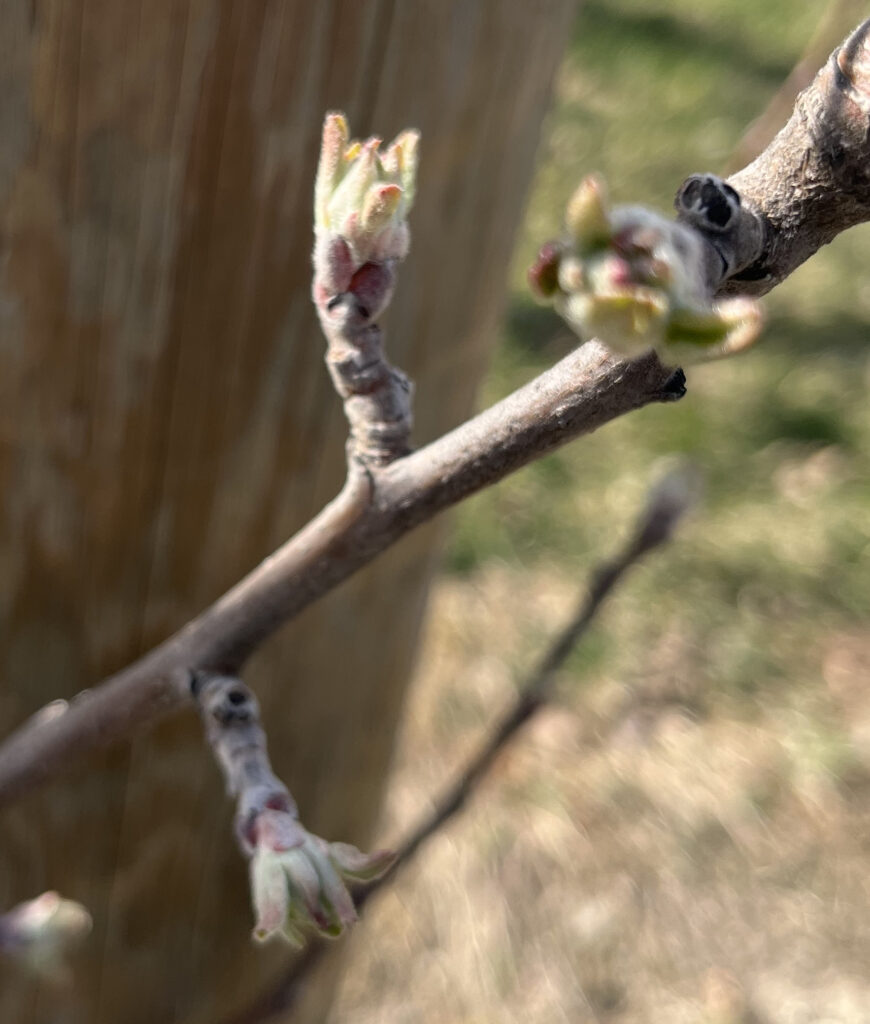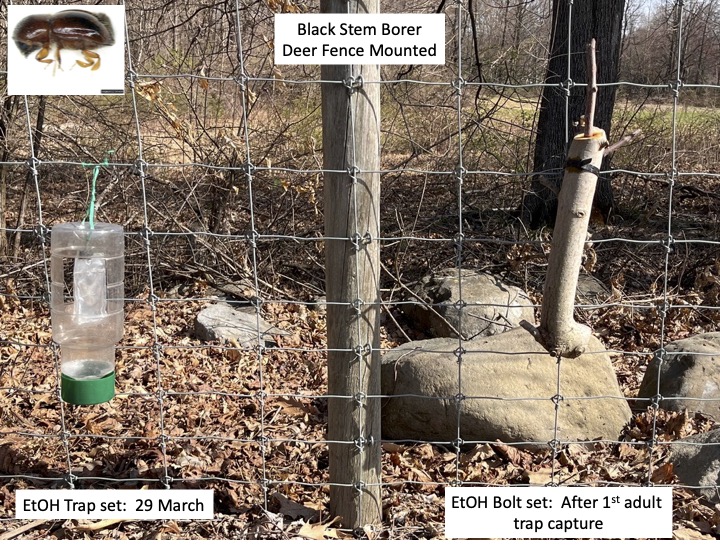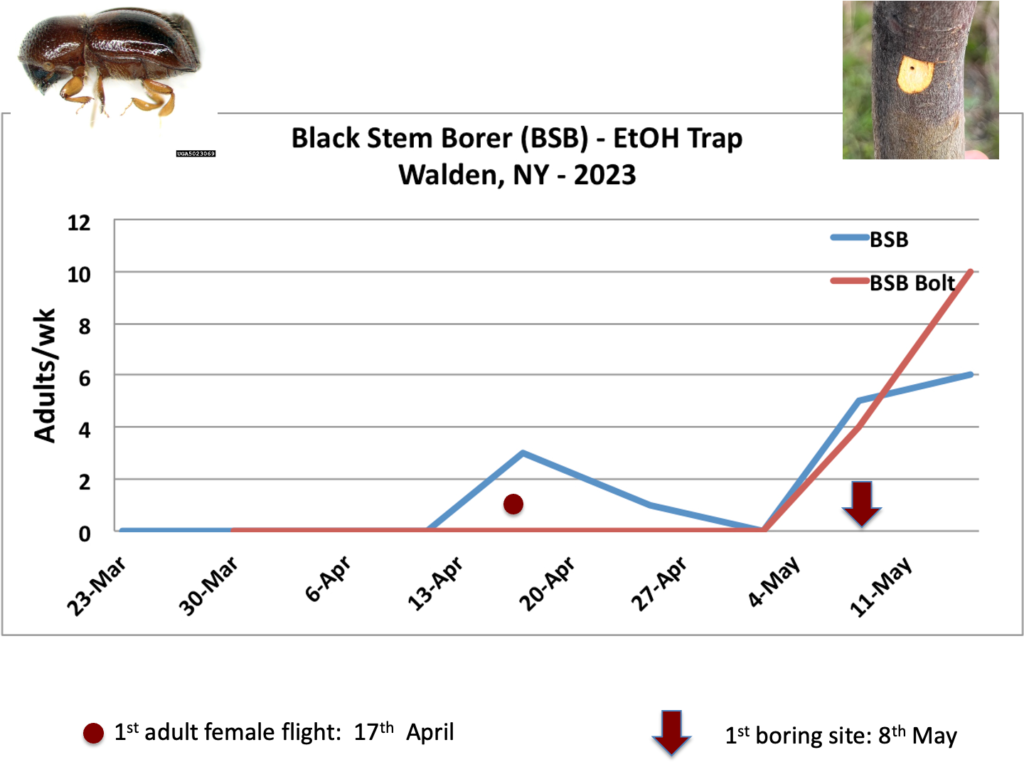Expect Black Stem Borer Emergence After Green-Tip.

Early varieties, such as Sweetango and Ginger Gold, are holding at green-tip in southern Hudson Valley orchards during this cold snap (Image Right). Most varieties remain at silver tip this week until temperatures rise.
Forecasts for night temperatures drop to the mid-low 20’s this week. Postponing oil applications should be considered if green tissue is showing so as to reduce freeze injury to newly developing leaves.
As temperatures rise next week, eggs lain on limbs during the previous season, specifically European red mite eggs (ERM), and San Jose Scale (SJS) populations, begin to require oxygen. Oil applied to trees with sufficient coverage in the spring, effectively kill ERM eggs and SJS adults.
Adding an insect growth regulator during pre-bloom (such as Esteem 35WP) will provide control of SJS and Rosy Apple Aphid (RAA) without the use of oil, Captain will likely be present by 1/2″ green depending on rain events and infection periods. Keeping oil applications well outside of a 7-10 day Captan application in spring will reduce the risk of phytotoxity to newly forming leaves.
Overview: The Black Stem Borer (BSB), Xylosandrus germanus is a species of ambrosia beetle that utilize trees with a compromised defense mechanism. Trees undergoing ‘stress’, such as young apple trees damaged from winter injury, will show signs of trunk injury at the ground level. Trees often express this as dead and dying bark cambium, causing flaked and decomposing bark at or below the soil line.
Adult female black stem borer locates stress trees which produce ethanol (EtOH). They fly to the tree and burrow into the trunk, creating galleries to rear their young (beetle grubs). Adults will then harvest ‘ambrosia’ fungal spores which grow within the gallery on which the grubs feed. The mycelium (fungal ‘roots) can grow through the wood and cambium to reduce tree health. The tree most often responds to this invasion by walling off the trunk cambium layer causing the demise of the tree.

When apple are planted on rootstock prone to winter injury, trunk cambium may freeze and die in part or completely. This causing tree decline and stress to the tree as it grows, producing ethanol (EtOH). The female BSB employs ETOH as a cue to find and invade the tree with a compromised defense system.
Scouting: To determine the presence of the insect in the orchard, examining trees expressing bark separation and look for fresh frass; examine the trunk from the base to 3′ into the 1st scaffold limbs, looking for sap ooze and ‘toothpick frass’. Begin trapping the insect as it migrates into the orchard using bottle, soapy water and EtOH pouch; determine the onset timing of adult burrowing using >1″ to 3″ diameter EtOH treated apple pruning bolts 1′ in length.

The use of insecticides, applied at the first sign of BSB tunneling of trees, often beginning in late March or early April into May, would likely reduce early BSB invasion of apple trunks during periods of weather extremes causing tree stress. Presently, pyrethroids appear to be the best option for directed spray applications to the tree trunks. Danitol 2.4EC and Warrior II 2.08CS are pyrethroid options. Brigade (Bifenthrin) used for brown marmorated stink bug may also have suppressant activity during the season.
One insecticide that has shown to be effective in trials to reduce infestation of BSB has been chlorpyrifos, unfortunately, now banned in NYS.
In-Depth: The ambrosia beetle, the black stem borer (BSB), Xylosandrus germanus (Blandford) (Coleoptera: Scolytidae) is the one Asian invasive insect pest for which we have a strong management option. Finding a solution for BSB infestations are critical to maintaining orchard productivity and long-term sustainability.

In New York State the use of chlorpyrifos (Lorsban-Dow/DuPont) ended for tree fruit on July 31, 2021, and the ban was in full effect throughout the US by EPA beginning February 2022 up to the Fall of 2023.
Yet a recent turn of events in the repeal for Lorsban use provides for the continuation of its use in 2024 in many states.
To recap, a review by the U.S. Court of Appeals for the 8th Circuit found that EPA was ‘arbitrary and capricious’ in this action because it did not allow for a public comment period or for an interagency review with the US Department of Agriculture. The USDA – Office of Pest Management Policy (OPMP) scientists believed, based on EPA’s own documents, that EPA could retain certain uses of chlorpyrifos that met EPA’s safety standards on 11 different crops, including apple, cherry, and peach.
In PA, the use of Pilot may provide growers a familiar tool to battle this pest. (“Lorsban/Pilot (Chlorpyrifos) is Back for Pennsylvania Tree Fruit in 2024” Dave Biddinger, Ph.D. Research Professor, Tree Fruit Research Entomologist).
Yet in NY, New York, which had banned chlorpyrifos use on food crops grown and sold, the ban will remain in effect unless modified at the state level. Biddinger adds that further restrictions on chlorpyrifos use are in place for some large buyers such as Whole Foods, and as such, packers such as Rice Fruit Company will not be able to accept fruit treated with Lorsban.
To date, hundreds, possibly thousands of young apple trees have been killed by this one insect pest in orchards throughout the Eastern US tree fruit growing region. (see prior post on this topic)
This BSB is attracted to young apple plantings under environmental or biotic stress. Stress include drought and heavy rain conditions, such as we’ve been experiencing over the past few years in the Hudson Valley. During these conditions the tree emits ethanol (ETOH) to which the BSB is highly attractive.
ETOH is an indication of tree stress and reduced defense mechanisms within the tree physiology, leading to greater insect infestation and higher levels of insect reproductive success.
The female first flight began in early April in the Mid-Hudson Valley in 2023 and 2021. The female emergence will be monitored using bottle traps with ETOH pouch lures, while burrowing into apple wood will be monitored using cut bolts of apple wood soaked in ETOH. The early onset of BSB attack of stressed apple trees can often be found from pink and bloom through petal fall and into the early season. A second generation occurs during mid-late summer. Given the cool spring, BSB beetle activity may be delayed this season.
A trunk application of Bifenthrin prior to bloom (Early May in the Hudson Valley) should be considered to reduce the boring activity of BSB into stressed newly planted or young apple. Following pest management options include Danitol 2.4EC at 16-21.3 fl.oz./A or Warrior II 2.08CS at 2.56 fl oz/100 gal water. Frequent applications may be required using the pyrethroid class of insecticides during the BSB attach cycle.

